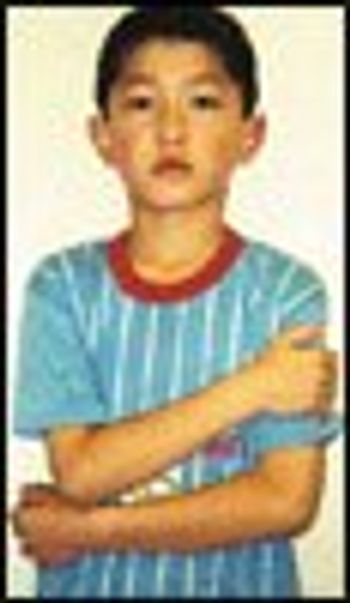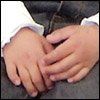
Dermatology
Latest News
CME Content


During a routine physical examination, a 3-year-old boy was noted to have speech delay and hyperactive behavior. The child was born at term to a 25-year-old mother with epilepsy, which was managed with phenytoin. His birth weight was 3.5 kg (7.8 lb); he had no neonatal problems or features of fetal Dilantin syndrome. However, he had undergone bilateral hydrocele and inguinal hernia repair and tube placement for recurrent ear infections. His half sister (from his mother's previous marriage) needs help in reading and math. His father is healthy.

Child Protective Services (CPS) has asked you to evaluate a 6-month-old girl with a genital mass. The goal is to determine whether the "weird lump in the baby's private area"--noted while the child's diapers were being changed in day care--was the result of sexual abuse.

Fourteen-year-old JT is worried. During health class last week, he learned about the different sexually transmitted infections as well as about testicular self-examination. While practicing his monthly testicular examination in the shower, he noticed that he had a number of small growths on his penis. On further questioning, JT insists that he has never been sexually active with another person.

A 12-year-old African American boy presented to the emergency department with a painless swelling on the left side of his head that had gradually progressed over a month. There was no history of pain, trauma, or fever. Findings from a review of all other systems were normal.

Medicine is at least as much art as science. Often things are not clear-cut, but rather appear in shades of gray. We offer the following list of terminology for those who don't mind thinking in terms of black or white.

A healthy, 3-year-old African-American girl is brought to your office for evaluation of hair loss. The child does not have a history of recent infection or medication use. She has not had any hair styling treatments and has not been subject to trauma or application of heat to the hair. What's the diagnosis?

Your doctor has just told you that you have an infection with human papillomavirus (HPV). Most teens have a lot of questions about warts and HPV. This guide will help answer some of those questions.

A 5-year-old girl is brought for evaluation of an asymptomatic inflamed streak on one leg that has been present for several weeks. She is otherwise healthy and takes no medications.

Several asymptomatic, erythematous papules and plaques had appeared on the hands of an otherwise healthy 11-year-old girl. The personal and family medical histories were noncontributory. A punch biopsy from the largest lesion on the palm confirmed the clinical diagnosis of localized granuloma annulare, a self-limited inflammation of the dermis

The "A" in the title stands for acrodermatitis enteropathica, an uncommon underlying cause of diaper dermatitis (DD). The "Pee," the colloquial term for urine, is probably the most common irritant (along with feces) that contributes to the breakdown of skin in the diaper area.

The prevalence and incidence of sinus infection, or sinusitis, is increasing and has been estimated to affect 31 million persons in the United States each year. It is one of the most common reasons why patients seek a physician's care. If left untreated, sinusitis can cause significant physical symptoms and can negatively affect quality of life by substantially impairing the daily functioning of sufferers. For children, this can mean learning difficulties at school and for adults, a loss of efficiency at work.

A healthy 16-year-old girl was bothered by a patch of white hair on her forehead; she also had a few white plaques on her abdomen, which had been present since birth. Her maternal great grandmother and maternal grandfather, as well as her mother, had a similar pattern of white hair.

Adolescents are at high risk for HPV infection because they tend to become involved with multiple simultaneous sexual partners rather than forming monogamous relationships.

Seven-year-old boy with red, nonpruritic rash that appeared first on the cheeks and then spread to the trunk, extremities, and buttocks. No history of respiratory, GI, or other symptoms in the several weeks before the onset of the rash. Patient is otherwise healthy.

What's causing a 7-month-old boy to be hospitalized for failure to thrive, recurrent wheezing, and bilateral infiltrates refractory to antibiotics?

What's causing a 7-month-old boy to be hospitalized for failure to thrive, recurrent wheezing, and bilateral infiltrates refractory to antibiotics?

What's the cause for an asymptomatic plaque that has been growing slowly on a boy's nose?

Early attention to maternal diet and infant nutrition may help prevent allergy and food intolerance in high-risk infants who are unable to be completely breastfed, according to recent data and speakers at a dinner symposium Sunday evening. Speakers Peyton Eggleston, MD, professor of pediatrics at Johns Hopkins University School of Medicine; Mark Boguniewicz, MD, National Jewish Medical and Research Center and University of Colorado School of Medicine; and John A. Kerner, MD, Stanford University School of Medicine, discussed the rising prevalence of allergic disease worldwide and the key factors shaping the trend, the progression of atopic disease in genetically predisposed children, the factors associated with risk of developing allergic disease, and the evidence for a role of diet in preventing allergic disease in young children.

The mother of this 3-year-old boy noticed that his smile was asymmetric when he awoke that morning. He had been seen 3 days previously for left ear discomfort, sore throat, and a low-grade fever. Otitis media was diagnosed, and amoxicillin was prescribed. The child has an unremarkable history and is otherwise healthy. He has been acting normally and tolerating food and liquids without difficulty.

The parents of a 7-year-old girl, who had fallen off her bicycle and hit her left forehead 2 weeks earlier, brought their daughter to the emergency department after she began having increasingly severe headaches. She had been healthy before her fall and had no history of other trauma or meningitis. She had no neurologic deficits on presentation. Examination of the fundus revealed no papilledema.

For several weeks, a 6-year-old girl has had a worsening mildly pruritic rash on the trunk. She has a history of seasonal allergies. The family has had a cat and a dog in the house for a number of years.

The patient, a 14-year-old boy, comes to see you the same day he was bitten by a dog. In the examination room, you find him seated comfortably in the chair with his right hand and arm bandaged.

A 7-year-old boy presented with an asymptomatic cystic lesion on the lateral aspect of the left ankle of 4 months' duration. There was no history of trauma. The mass fluctuated in size: it was smaller when the child was recumbent and larger when the child was upright.

A 9-year-old girl was hospitalized because of a painful, vesicular rash on her genitals, groin, and buttocks. There was also concern about possible genital herpes infection in a minor.





